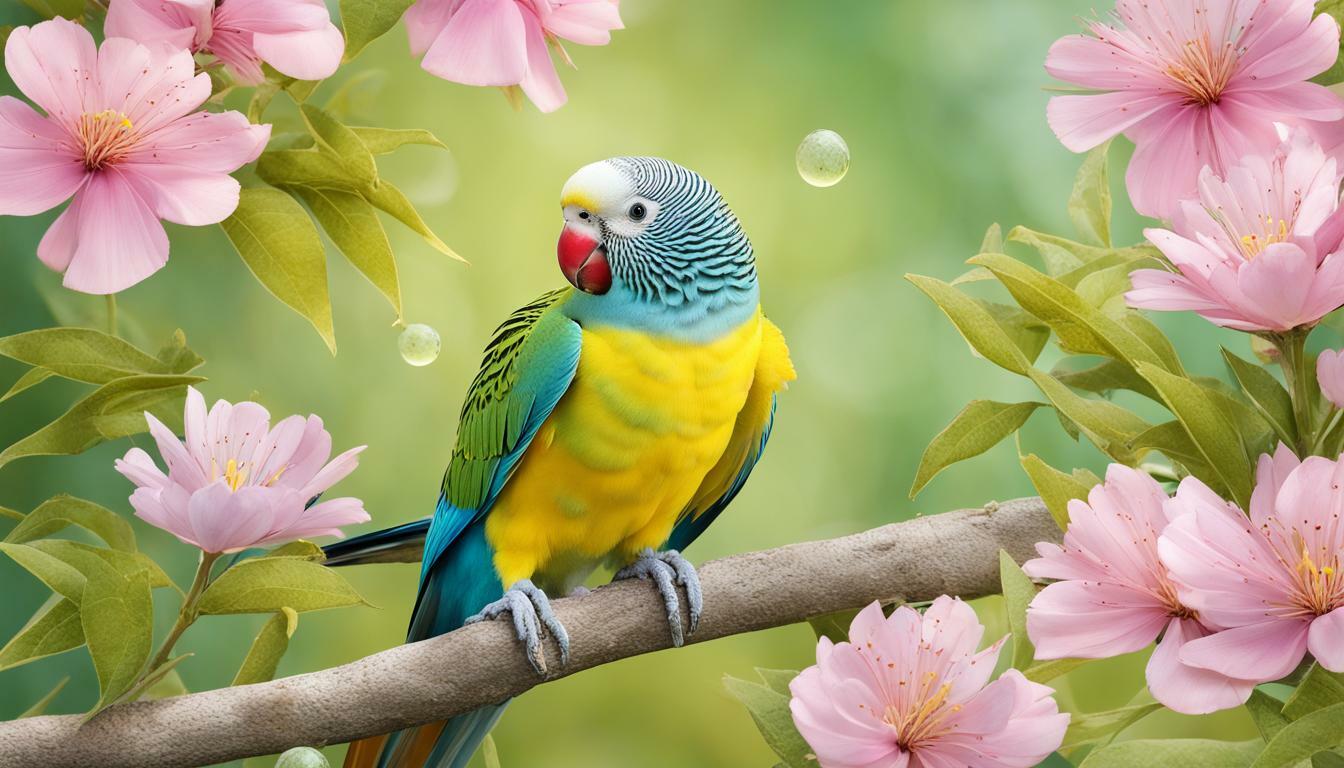If you own a female parakeet, you may have wondered whether she can lay eggs without a male. The answer is yes, female parakeets can lay eggs without mating with a male parakeet. This is known as parthenogenesis or asexual reproduction.
However, it’s important to note that eggs laid through parthenogenesis are not fertile and will never hatch into baby parakeets. In order for an egg to be fertilized and hatch, a male parakeet’s sperm must fertilize the female’s eggs during mating.
Key Takeaways:
- Female parakeets can lay eggs without mating with a male parakeet.
- Eggs laid through parthenogenesis are not fertile and will not hatch into baby parakeets.
- A male parakeet’s sperm must fertilize a female’s eggs during mating for them to be fertile and hatch into baby parakeets.
Understanding Parakeet Reproduction
If you’re interested in breeding parakeets, it’s important to understand the basics of their reproduction process. Parakeets reproduce sexually, with both male and female birds playing a crucial role in the process.
Parakeets are monogamous creatures, which means they typically choose a mate for life. Courtship rituals are an essential part of the breeding process, during which the male and female birds interact and bond. Once a pair has formed a strong bond, they are ready to begin the process of reproduction.
The female parakeet is responsible for producing eggs. When a female is ready to lay eggs, she will display certain behaviors, such as frequent trips to the nest box and increased vocalizations. Parakeets can lay eggs even without a male present, but these eggs will not be fertilized and will not hatch into chicks.
In order for fertilization to occur, a male parakeet must be present to mate with the female. After mating, the female will lay eggs that are fertilized by the male’s sperm. The number of eggs that a female can produce in one breeding season depends on various factors, such as her age, health, and environmental conditions.
The eggs usually hatch after about 18-20 days of incubation, with the chicks being dependent on their parents for food and care for several weeks. Once the chicks are fully fledged, they can leave the nest box and begin to explore their surroundings.
In summary, parakeets reproduce sexually, with both males and females playing important roles in the process. Female parakeets lay eggs, which are fertilized by male sperm. If you’re considering breeding parakeets, it’s crucial to understand these basics so you can provide a conducive environment for your birds to successfully reproduce.
Female Parakeet Egg Laying Cycle
Female parakeets have a natural egg-laying cycle, which is influenced by a variety of factors such as age, environmental conditions, and overall health. The egg-laying process typically begins around six months of age, although it can vary slightly between individual birds.
During the egg-laying cycle, a female parakeet will typically lay one egg every other day until she has produced a clutch of four to eight eggs. The eggs will then be incubated for approximately 18-20 days before hatching.
| Egg Laying Stages | Description |
|---|---|
| Pre-laying | During the pre-laying stage, the female parakeet will often become more vocal and restless. She may also spend more time in her nesting box, preparing it for egg-laying. |
| Egg Formation | During the egg formation stage, the female’s body will prepare the egg inside her reproductive system. This process takes approximately 24-36 hours per egg. |
| Egg Laying | When the egg is ready to be laid, the female will lay it in her nesting box. This stage can occur every other day until she has laid all of her eggs for the clutch. |
| Incubation | After all of the eggs have been laid, the female will start to incubate them. During this stage, the eggs are kept warm and the embryos develop inside the eggs. |
It is important to note that female parakeets can lay eggs without the presence of a male, but these eggs will not be fertilized and will not hatch. If you do not plan on breeding your parakeets, it is recommended to provide them with a nest box filled with nesting material to discourage egg-laying behavior. Excessive egg-laying can be stressful for female parakeets and may lead to health issues.
Parakeet Breeding Behavior
Parakeets are social birds that exhibit a variety of breeding behaviors during the breeding season. Understanding their behavior can help you create a conducive environment for successful breeding. This section will explore some of the behaviors exhibited by parakeets during the breeding season, emphasizing the role of mate selection and courtship rituals.
Parakeets are monogamous birds, meaning they mate for life. They form strong bonds with their mates and will often display affection towards each other. During the breeding season, which typically begins in the spring, parakeets exhibit various courtship rituals that serve to strengthen their bond.
One of the most common courtship behaviors in parakeets is called “billing”. This is where the male and female parakeet touch beaks and move their heads in a circular motion. This behavior serves to reinforce their bond and prepares them for mating.
Once the bond between the parakeets is established, they will begin to exhibit nesting behavior. This involves the male and female parakeet selecting a nesting site and preparing it for the arrival of their offspring. They will collect nesting materials such as twigs, grass, and leaves to build the nest.
Mate selection is also an important aspect of parakeet breeding behavior. Parakeets typically choose their mates based on physical appearance, personality, and vocalization. It is important to choose a suitable mate for your parakeet to ensure successful breeding and a healthy offspring.
If you plan on breeding your parakeets, it is important to provide them with a conducive environment. This includes providing a large enough cage for both parakeets, access to nesting materials, and a healthy diet. A healthy diet consisting of fresh fruits, vegetables, and high-quality pellets will ensure optimal breeding conditions.
In summary, understanding parakeet breeding behavior, including mate selection and courtship rituals, is crucial for successful breeding. Providing a conducive environment and a healthy diet will help ensure optimal breeding conditions for your parakeets.
The Role of Males in Parakeet Breeding
While female parakeets are capable of laying eggs without a male present, fertilization is not possible without a male contribution. Male parakeets play a vital role in successful reproduction, as they are responsible for fertilizing the eggs laid by females.
During the breeding season, male parakeets exhibit specific behaviors aimed at attracting a mate and engaging in courtship rituals. These may include singing, displaying bright colors, and performing aerial acrobatics to impress females.
The role of the male parakeet extends beyond mating, however. Once eggs are laid, the male maintains an active presence, taking turns with the female to incubate the eggs and care for the chicks once they hatch.
If you are considering breeding parakeets, it is essential to have a male present to ensure successful fertilization. Additionally, providing a suitable environment and proper nutrition for both male and female parakeets can significantly increase the likelihood of healthy reproduction.
Reproduction Process of Parakeets
Parakeets are known for their beautiful plumage and cheerful chirping, but they also have a fascinating reproduction process. If you’re interested in learning more about parakeet breeding, here’s a step-by-step guide to the reproduction process of parakeets.
1. Courtship and Mating
The first step in the reproduction process is courtship and mating. When a male and female parakeet are ready to mate, they will engage in a series of behaviors that include vocalizations, feeding each other, and preening. Once the male has successfully courted the female, they will mate by rubbing their cloacas together. This is known as a “cloacal kiss” and is essential for fertilization to occur.
2. Egg Laying
After mating, the female parakeet will begin egg production. Female parakeets typically lay eggs every other day until they have laid a complete clutch. The timing and frequency of egg laying can be influenced by various factors such as age, health, diet, and environmental conditions. Once the clutch is complete, the female parakeet will begin incubating her eggs.
3. Incubation and Hatching
During the incubation period, the female parakeet will sit on her eggs to keep them warm and ensure their proper development. Parakeet eggs typically take around 18-21 days to hatch. Once the eggs hatch, the parents will take turns feeding and caring for their chicks until they are ready to fledge.
4. Fledging and Weaning
When the chicks are ready to fledge, they will leave the nest and begin exploring the world around them. Fledgling parakeets are not yet independent and will continue to rely on their parents for food and care. As they grow, the parents will gradually wean their chicks off of their own food and encourage them to feed themselves.
And that’s the reproduction process of parakeets! With the right care and environment, these beautiful birds can reproduce successfully and bring joy to their owners through their vibrant colors and playful personalities.
Factors Influencing Parakeet Egg Production
If you are a parakeet owner, you may be wondering what factors have an impact on your female parakeet’s egg production. Several factors can influence the frequency and quantity of eggs that your parakeet lays. Understanding these factors can help you provide the best possible environment for your feathered friend.
Age
Age is a significant factor that can affect the egg-laying ability of female parakeets. Generally, younger parakeets will produce more eggs than older ones. While parakeets can lay eggs throughout their lives, egg production tends to decline as they age. If your parakeet is over three years old and has decreased egg production, it may be due to age-related factors.
Health
The overall health of your parakeet is also a crucial factor in its egg-laying ability. If your parakeet is not in optimal health, it may not lay as many eggs as a healthy bird. Factors that can affect your parakeet’s health and, consequently, its egg-laying ability include malnutrition, disease, parasites, and stress.
Diet
The diet of your parakeet can significantly impact its egg production. A well-balanced diet that includes fresh fruits, vegetables, and high-quality seed mix can contribute to optimal egg production. Ensure that your parakeet has access to clean and fresh drinking water at all times.
Environmental Conditions
The environment that your parakeet lives in can also influence its egg production. Factors such as lighting, temperature, and humidity levels can affect the frequency and quantity of eggs produced. Parakeets tend to lay more eggs during the warmer months of the year, and shorter daylight hours can also decrease egg production.
By taking measures to ensure that your parakeet is in good health, has a healthy diet, and lives in a conducive environment, you can help maximize its egg-laying ability.
Conclusion
In summary, female parakeets are capable of laying eggs without a male present, but the eggs will not be fertilized and will not hatch. Understanding parakeet reproduction and breeding behaviors is crucial for the health and well-being of your pet bird. Providing a conducive environment and a healthy diet can greatly influence the frequency and quality of egg production. If you are interested in breeding parakeets, it is important to learn as much as possible about their breeding cycle and behaviors, as well as the care and maintenance required for healthy offspring. We hope this article has provided you with valuable insights into the fascinating world of parakeet reproduction and care.What is the Reproduction Process for Birds, Including Penguins and Parakeets?
Penguin reproduction explained: Penguins have a unique reproduction process. They form monogamous pairs and lay eggs. Both the male and female take turns incubating the egg and providing care for the chick. Parakeets, on the other hand, also reproduce by laying eggs but typically form socially monogamous pairs. Understanding the intricate reproductive behaviors of birds, including penguins and parakeets, helps us appreciate their fascinating life cycles.
FAQ
Q: Do parakeets lay eggs without a male?
A: No, parakeets require a male for fertilization to occur and egg production to take place.
Q: How do parakeets reproduce?
A: Parakeets reproduce through a process called sexual reproduction, where a male and female parakeet mate and the female lays eggs.
Q: What is the female parakeet’s egg laying cycle?
A: The female parakeet’s egg laying cycle consists of several stages, including courtship, mating, egg production, and incubation.
Q: What are some common parakeet breeding behaviors?
A: Parakeets exhibit various breeding behaviors during the breeding season, such as courtship displays, nest building, and territorial defense.
Q: What is the role of males in parakeet breeding?
A: Males play a crucial role in parakeet breeding as they are responsible for fertilizing the eggs laid by the female parakeet.
Q: How does the reproduction process of parakeets work?
A: The reproduction process of parakeets involves courtship displays, mate selection, mating, egg fertilization, and incubation.
Q: What factors can influence parakeet egg production?
A: Several factors can influence a female parakeet’s egg production, including age, health, diet, and environmental conditions.











